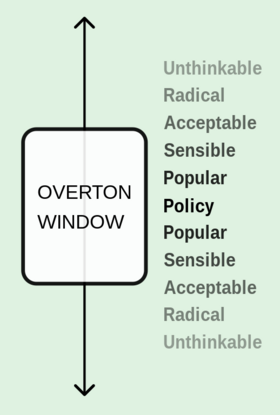Overton window
The Overton window is a concept developed by right-libertarian[1] political scientist Joseph Overton to refer to the range of policy choices as situated on a left-right political spectrum which are considered acceptable to discuss and implement in a liberal democracy. According to the theory, voters consider policies within the "window" to be acceptable, whereas as the further these ideas deviate from the mean, the more radical, extreme and, at the furthest left and right, unacceptable they are to discuss. "Shifting the Overton window" means to move or widen the range of policies which are permitted, such as, for example, by favoring right-wing ideas, shifting public opinion to view them as increasingly mainstream at the cost of leftist ones, which in turn become more "extreme".
"Shifting" the window is almost always the result of a concerted political effort, and every political interest group in a bourgeois democracy arguably aims to shift the window to further its goals. This can take the form of grassroots action but more often implies a concerted media or political effort, such as the "shift" in United States political discourse which, some leftists argue, accompanied Bernie Sanders's 2016 political campaign. The idea was codified and named in the 2000s by Joseph Overton's colleague Joseph Lehman,[1] who argued, “The most common misconception is that lawmakers themselves are in the business of shifting the Overton window. That is absolutely false. Lawmakers are actually in the business of detecting where the window is, and then moving to be in accordance with it.”[1]
The concept was developed specifically to describe electoral bourgeois democracy and can be useful for this purpose. However, it differs from a historical materialist understanding of political change, in which political positions are developed from the consciousness of everyday experience and can vary significantly from the left-right political spectrum.[citation needed] In addition, "public opinion" is to some extent a liberal concept which conflates the beliefs and interests of the masses with the rhetoric of hegemonic institutions like the media, academia, and think tanks. Shifting the views of the masses regarding what is possible is the object of a communist party, including through electoral action. In a sense, a kind of sudden Overton shift occurs during a social revolution as impossible ideas suddenly become real. A very different kind of Overton window, then, allowed the Jacobin movement to follow the revolutionary overthrow of the king; the reconstitution of Russian society within years of the fall of the tsar; the birth of the Digger movement in the midst of the regicidal English Civil War; or the building of a socialist state in Cuba after decades of colonial oppression.
The anarchist intellectual Noam Chomsky employs an analysis of US politics which is related to the Overton window:
The smart way to keep people passive and obedient is to strictly limit the spectrum of acceptable opinion, but allow very lively debate within that spectrum - even encourage the more critical and dissident views. That gives people the sense that there's free thinking going on, while all the time the presuppositions of the system are being reinforced by the limits put on the range of the debate.[2]
See also
References
- ↑ 1.0 1.1 1.2 Robertson, Derek (25 Feb 2018). "How an Obscure Conservative Theory Became the Trump Era's Go-to Nerd Phrase". POLITICO Magazine. Retrieved 28 Aug 2023.
- ↑ Chomsky, Noam; Barsamian, David; Naiman, Arthur (1998). The Common Good. Monroe, ME: Odonian Press: Distributed through Common Courage Press/LPC Group. ISBN 978-1-878825-08-7. OCLC 39533848. Quoted at "The Common Good by Noam Chomsky". Third World Traveler. Retrieved 28 Aug 2023.
